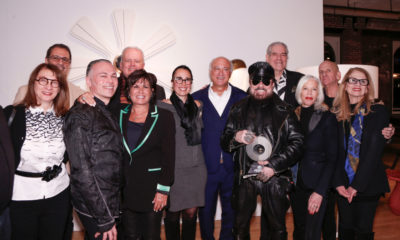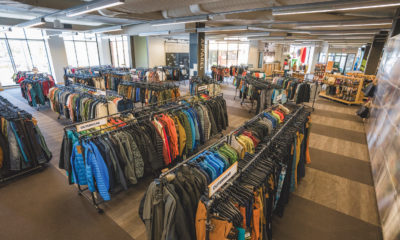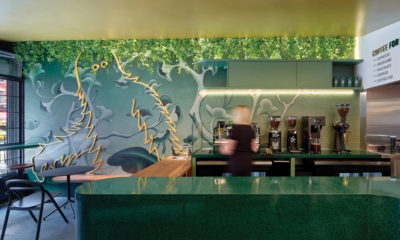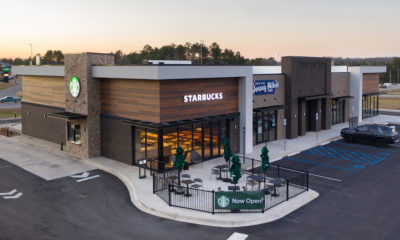After a day of wandering the streets in New York and exploring retail shops in Brooklyn a few weeks ago, some fellow designer friends and I spent the evening at the Brooklyn Museum. An unexpected find, the museum houses possibly one of the most progressive art exhibits in New York. It’s a largely unknown treasure that many visitors don’t get a change to explore, so you should definitely visit the next time you’re in the city. Fortunately for me, an amazingly sensorial exhibition was taking place.
The Faile Bäst Deluxx Fluxx Arcade 2015, Brooklyn Museum, New York (Photography: Rebekah L. Matheny, Columbus, Ohio)
When Brooklyn-based artist Faile stepped on the scene in 2010 with their exhibit, Deluxx Fluxx Arcade, they brought the atmospheric life of a throwback ’80s arcade and the vibrancy and grit of graffiti culture to the art scene. Having just experienced their recent exhibition, Savage/Sacred Young Minds, I can attest to the effervescence that permeates the exhibition. Evocative of ’80s punk rock, street-art culture and arcades, the Arcade 2015 exhibit is a series of rooms that creates an immersive experience. Their graffiti-style iconographic posters envelop the walls as a wallcovering material would, and the floors are like tiles with a glowing neon pattern and texture. The series of spaces are washed in a luminous combination of neon and black lights, filled with the boisterous sounds of video games, pinball machines and foosball tables. Witnessing the energy exuding from the crowds of people interacting with the exhibit, I wondered: How could we harness this intoxicating energy in a retail environment?
The Faile Bäst Deluxx Fluxx Arcade 2015, Brooklyn Museum, New York (Photography: Rebekah L. Matheny, Columbus, Ohio)
Everywhere you turn, there seems to be a nod to the street-art culture which Faile is evoking in the exhibit. The aesthetic isn’t limited to art museums, either: From the patterns, colors and textures of materials to neon lights (even if they are LEDs made to look like neon tubes), these elements are steadfastly making a comeback and filling our environments – even through the fashion and accessories hitting the streets of New York and London – this vibrant, bold style is emerging.
I also noticed this trend in a recent visit to The London Cocktail Club in both the Soho and Shortditch areas of London. These underground bars were attuned to the same energy that Faile evokes in their Arcade exhibit. Custom wallcoverings wrap the space in a similar fashion, while neon-colored, large graffiti murals create a dynamic expression for each location. The sounds of people playing foosball or pinball permeate the atmosphere, and neon lights create an ambiance within the bar, as black lights make the rooms glow. All this, plus the unique tastes of their custom cocktails, made it a totally sensorial experience.
The London Cocktail Club, Soho, London (Photography: Rebekah L. Matheny, Columbus, Ohio)
Both the art exhibit and the fully immersive cocktail bar embrace this trend in the choice of aesthetic elements, but also, and more importantly, by tapping into the total sensory experience – the sights, sounds and touch truly make the experience special. In an interview, Faile points out, “Living in a place like New York, there is a constant barrage of sounds and sights – how do you make meaning from it all?” And that’s exactly what they’re doing through their work.
So this concept begs the questions: How, as retail designers, can we tap into this dynamism in our own designs? How do we embrace this vibrancy in creating a totally sensorial experience for our customers? Where will this energy take us in the future?
Just like Faile makes sense of Brooklyn, I challenge you to think about the sights and sounds of your specific locale, and use the cultural vitality to transport customers in your store environment. Think about how you can engage the shoppers and create moments of physical interaction that tap into their sensory perception, while providing energy that the other customers can feed from. And don’t forget the importance of materials and lighting within your store environment – a single custom wallcovering can capture your brands identity and make a glowing statement!
Rebekah L. Matheny is an Assistant Professor of Interior Design at The Ohio State University where she teaches courses in Interior Finish Materials, Lighting Design, and Design Studios that integrates a retail brand strategy process. Matheny’s research investigates the sensory perception of interior finish materials and their application in retail design to create emotional connections between the customer and the brand. For more of Matheny’s insights, see her previous blog post, “Retail on Foot,” and read her latest publication “Reclaimed wood in retail environments: creating an emotional connection for product longevity.”
To learn more about why interior finish materials matter and how to connect with the sensory perception, join Rebekah Friday, Sept. 11 at IRDC from 9:30-9:55 a.m. for her Power Track A (“Sharpening Your Skills”) session, “Interior Materials Matter: Creating Emotional Connections through Sensory Experiences.” For more information about IRDC, visit irdconline.com.


 Photo Gallery6 days ago
Photo Gallery6 days ago
 Headlines2 weeks ago
Headlines2 weeks ago
 Headlines6 days ago
Headlines6 days ago
 Headlines1 week ago
Headlines1 week ago
 Headlines2 weeks ago
Headlines2 weeks ago
 Headlines7 days ago
Headlines7 days ago
 Designer Dozen2 weeks ago
Designer Dozen2 weeks ago
 Special Reports2 weeks ago
Special Reports2 weeks ago

















